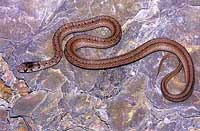Web Site Makes Kentucky Snake Identification Easier
Web Site Makes Kentucky Snake Identification Easier

Snakes are a common wildlife species in many Kentucky landscapes, even in urban areas. Knowing how to identify a snake that is slithering around may help ease fear and calm nerves.
The University of Kentucky Cooperative Extension Service designed a web site for county Extension agents, teachers, students, campers, tourists and anyone else interested in snake identification. The site has color pictures of every snake known to exist in Kentucky.
"We wanted to get across the message that anyone can identify snakes, even without having to count scale rows or examine fine details," said Tom Barnes, UK wildlife management specialist and wildlife photographer. "This page is designed to teach people to make some basic decisions from a distance including color, pattern, distribution, and habitat. Some snakes are easy to identify on color and pattern alone."
The web site is organized into nine specific categories including poisonous, non-poisonous, patterned, striped, solid, backyard snakes, common name, species name and geographic region.
"This way if a person already knows something about the snake, it will be easier to find it on the web site," Barnes said.
Barnes said basically there are seven key things to observe when trying to identify a snake. They are length, body shape, head and neck shape, color and pattern, scale texture, eye pupil shape and anal plate division.
When viewers choose a snake on the web site, they will see many details about that particular snake. For example, viewers can zoom-in to see a bigger picture of the snake or to see its head detail. There also is an option to view snakes in their juvenile states. Along with a detailed description of each, there is a picture of Kentucky with color shaded areas indicating the most common regions where the snake can be found.
"The distribution maps give the viewer a generalized sense of where the snake occurs in Kentucky, not specific counties," Barnes said.
The Internet address for the Kentucky Snake Identification web site is www.kentuckysnakes.org. The site also contains links to several helpful organizations and resources, as well as a UK publication with information about snakes for Kentucky homeowners. In Barnes' opinion one of the most helpful links deals with preventing and treating snakebites.
Barnes said the site is not intended for biologists or herpetologists, who usually require much more technical information. He also encourages people who are not sure about a particular snake to contact the Kentucky Department of Fish and Wildlife, a biologist or a local college or university to make a positive identification.